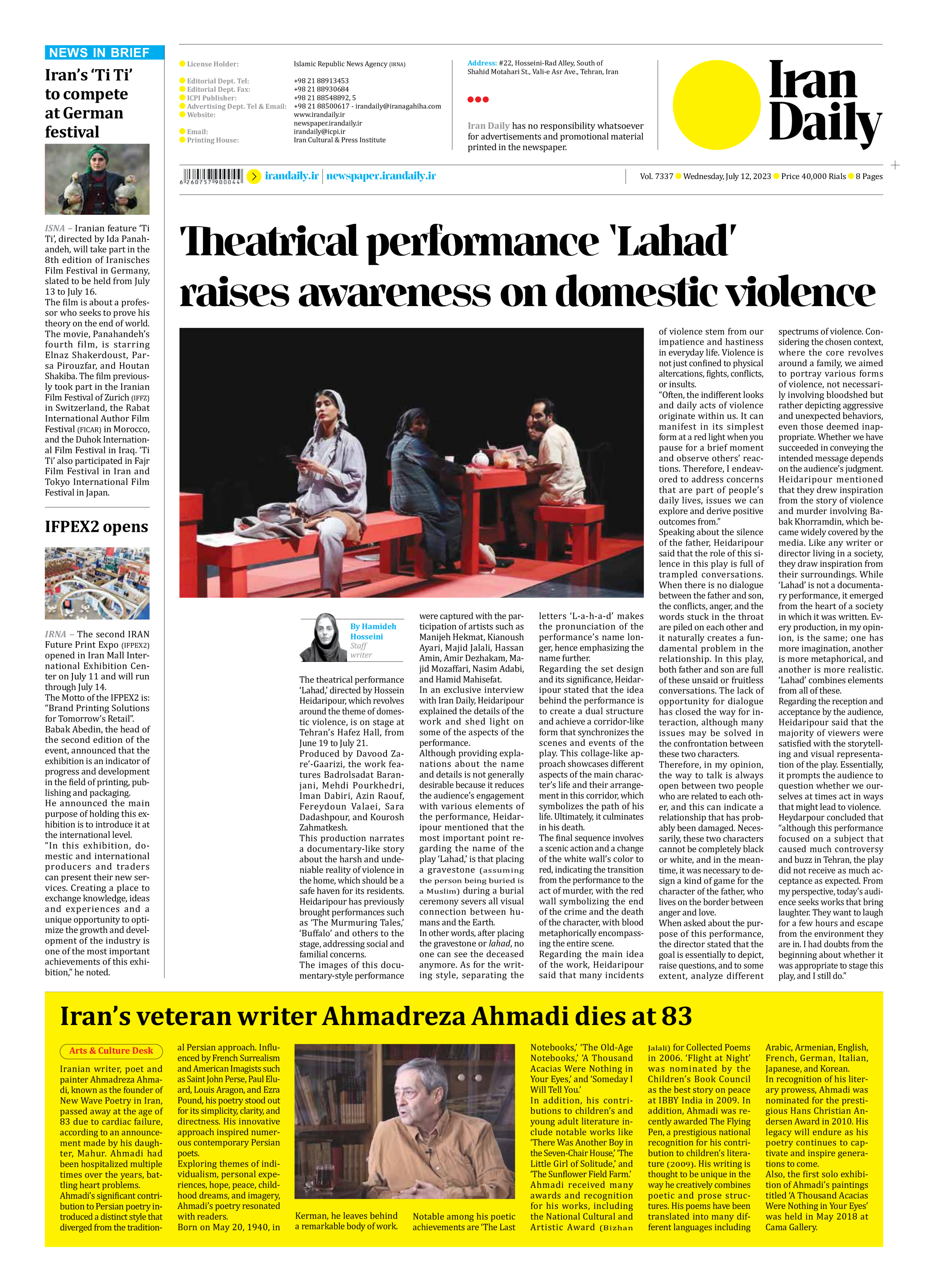
Theatrical performance ‘Lahad’ raises awareness on domestic violence
By Hamideh Hosseini
Staff writer
The theatrical performance ‘Lahad,’ directed by Hossein Heidaripour, which revolves around the theme of domestic violence, is on stage at Tehran’s Hafez Hall, from June 19 to July 21.
Produced by Davood Zare’-Gaarizi, the work features Badrolsadat Baranjani, Mehdi Pourkhedri, Iman Dabiri, Azin Raouf, Fereydoun Valaei, Sara Dadashpour, and Kourosh Zahmatkesh.
This production narrates a documentary-like story about the harsh and undeniable reality of violence in the home, which should be a safe haven for its residents. Heidaripour has previously brought performances such as ‘The Murmuring Tales,’ ‘Buffalo’ and others to the stage, addressing social and familial concerns.
The images of this documentary-style performance were captured with the participation of artists such as Manijeh Hekmat, Kianoush Ayari, Majid Jalali, Hassan Amin, Amir Dezhakam, Majid Mozaffari, Nasim Adabi, and Hamid Mahisefat.
In an exclusive interview with Iran Daily, Heidaripour explained the details of the work and shed light on some of the aspects of the performance.
Although providing explanations about the name and details is not generally desirable because it reduces the audience’s engagement with various elements of the performance, Heidaripour mentioned that the most important point regarding the name of the play ‘Lahad,’ is that placing a gravestone (assuming the person being buried is a Muslim) during a burial ceremony severs all visual connection between humans and the Earth.
In other words, after placing the gravestone or lahad, no one can see the deceased anymore. As for the writing style, separating the letters ‘L-a-h-a-d’ makes the pronunciation of the performance’s name longer, hence emphasizing the name further.
Regarding the set design and its significance, Heidaripour stated that the idea behind the performance is to create a dual structure and achieve a corridor-like form that synchronizes the scenes and events of the play. This collage-like approach showcases different aspects of the main character’s life and their arrangement in this corridor, which symbolizes the path of his life. Ultimately, it culminates in his death.
The final sequence involves a scenic action and a change of the white wall’s color to red, indicating the transition from the performance to the act of murder, with the red wall symbolizing the end of the crime and the death of the character, with blood metaphorically encompassing the entire scene.
Regarding the main idea of the work, Heidaripour said that many incidents of violence stem from our impatience and hastiness in everyday life. Violence is not just confined to physical altercations, fights, conflicts, or insults.
“Often, the indifferent looks and daily acts of violence originate within us. It can manifest in its simplest form at a red light when you pause for a brief moment and observe others’ reactions. Therefore, I endeavored to address concerns that are part of people’s daily lives, issues we can explore and derive positive outcomes from.”
Speaking about the silence of the father, Heidaripour said that the role of this silence in this play is full of trampled conversations. When there is no dialogue between the father and son, the conflicts, anger, and the words stuck in the throat are piled on each other and it naturally creates a fundamental problem in the relationship. In this play, both father and son are full of these unsaid or fruitless conversations. The lack of opportunity for dialogue has closed the way for interaction, although many issues may be solved in the confrontation between these two characters.
Therefore, in my opinion, the way to talk is always open between two people who are related to each other, and this can indicate a relationship that has probably been damaged. Necessarily, these two characters cannot be completely black or white, and in the meantime, it was necessary to design a kind of game for the character of the father, who lives on the border between anger and love.
When asked about the purpose of this performance, the director stated that the goal is essentially to depict, raise questions, and to some extent, analyze different spectrums of violence. Considering the chosen context, where the core revolves around a family, we aimed to portray various forms of violence, not necessarily involving bloodshed but rather depicting aggressive and unexpected behaviors, even those deemed inappropriate. Whether we have succeeded in conveying the intended message depends on the audience’s judgment.
Heidaripour mentioned that they drew inspiration from the story of violence and murder involving Babak Khorramdin, which became widely covered by the media. Like any writer or director living in a society, they draw inspiration from their surroundings. While ‘Lahad’ is not a documentary performance, it emerged from the heart of a society in which it was written. Every production, in my opinion, is the same; one has more imagination, another is more metaphorical, and another is more realistic. ‘Lahad’ combines elements from all of these.
Regarding the reception and acceptance by the audience, Heidaripour said that the majority of viewers were satisfied with the storytelling and visual representation of the play. Essentially, it prompts the audience to question whether we ourselves at times act in ways that might lead to violence.
Heydarpour concluded that “although this performance focused on a subject that caused much controversy and buzz in Tehran, the play did not receive as much acceptance as expected. From my perspective, today’s audience seeks works that bring laughter. They want to laugh for a few hours and escape from the environment they are in. I had doubts from the beginning about whether it was appropriate to stage this play, and I still do.”







